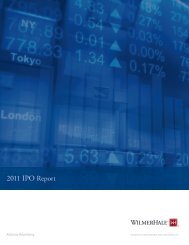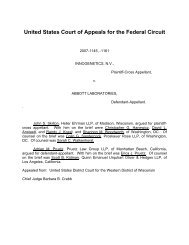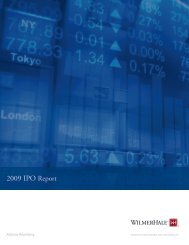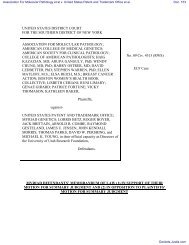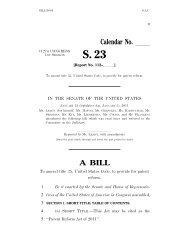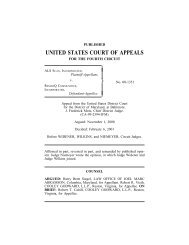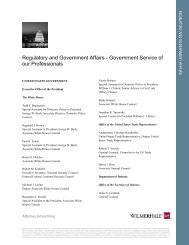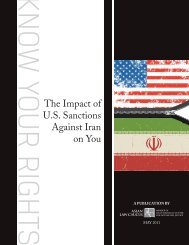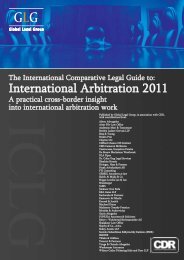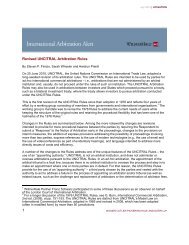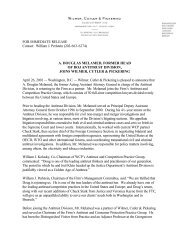2008 IPO Report - Initial Public Offerings
2008 IPO Report - Initial Public Offerings
2008 IPO Report - Initial Public Offerings
You also want an ePaper? Increase the reach of your titles
YUMPU automatically turns print PDFs into web optimized ePapers that Google loves.
20 <strong>IPO</strong>s – Then and NowThe tenth anniversary of our annual<strong>IPO</strong> <strong>Report</strong> caused us to reflect a biton the <strong>IPO</strong> market.From a distance, today’s <strong>IPO</strong> processlooks much the same as that of ageneration ago or even 5 to 10 yearsago. In fundamental ways, the processhas scarcely changed—you gather at anorganizational meeting, hold multipledrafting and diligence sessions, file a FormS-1 registration statement with the SEC,resolve SEC comments, pitch investorson a road show, meet at a financialprinter to finalize the prospectus, signthe underwriting agreement, and thenprice and close the deal. But below 30,000feet, many changes become apparent:■More Extensive Preparation: Far morepreparation—legal, accounting, financial,governance and organizational—is nowrequired for an <strong>IPO</strong>, and the work comesearlier in the process. <strong>IPO</strong> candidatesused to select a lead underwriter andhold an organizational meeting to kickoff the <strong>IPO</strong> process, with little advancepreparation. Now, if the company hasnot invested several months or morein getting ready to go public, the <strong>IPO</strong>schedule will lag well behind underwriterexpectations as well as the pace ofother companies in the <strong>IPO</strong> queue.■Additional Disclosure: Disclosurerequirements have mushroomed in recentyears. Companies need to provide muchmore extensive and elaborate disclosurein areas such as MD&A; executivecompensation, including the new CD&A;risk factors; and the financial statementsand footnotes. Much of this stemsfrom new and expanded SEC and stockexchange rules, but other aspects reflectmore demanding investor expectations.As a result of these changes, prospectuseshave ballooned in length, routinelyexceeding 150 pages and requiringsummaries of 5–10 pages or more.■Plain English: Prospectuses are nowwritten in “plain English,” a foreignlanguage to old-school securities lawyerswho trafficked in defined terms, legaljargon, long sentences and even longerparagraphs. Most practitioners willadmit that plain English has beena rousing success, although it is morethan a bit ironic that as prospectuseshave become much simpler to readthey have also become much longer.■Lengthier (but More Transparent) SECReview Process: SEC review now involvesmore comment letters and a lengthierprocess. Whereas it used to be possibleto clear all SEC comments with as fewas one or two letters, three or more setsof comments is now typical. As a result,it is almost unheard of to print redherrings and begin a road show basedon the initial Form S-1 filing or thecompany’s response to the first commentletter alone—a common practice wellinto the 1990s. The SEC now publiclyreleases comment letters and companyresponses after completing its review ofregistration statements, providing bettervisibility into the SEC review process.■Changes in Underwriting Practices:Most <strong>IPO</strong>s now have three or fourmanaging underwriters, but syndicateshave become smaller as investmentbanking firms have become much largerthrough industry consolidation. Roadshows are longer, and frequently includetrips to Europe. Marketing reach isusually expanded with electronic roadshows. The roles of investment bankersand securities analysts are now separatedin the offering process, changingthe way <strong>IPO</strong> companies interact witheach. Free writing prospectuses cannow be used to update information,and post-effective prospectus deliveryobligations can be satisfied with a noticethat the sale was made pursuant to aregistration statement. Standard lockupagreements usually can be extendedif the company announces earningsor material developments toward theend of the initial lockup period.■Longer Timeline: The timeline frominitial Form S-1 filing to closing hasbecome much longer. Prior to 2000or so, an <strong>IPO</strong> candidate could reasonablyexpect to complete the <strong>IPO</strong> within45–60 days after filing. Today’s normis twice that. The longer the <strong>IPO</strong>process, the more opportunities forthe offering to be delayed or scuttleddue to market conditions or companydevelopments, causing many proposed<strong>IPO</strong>s to proceed in fits and starts.■Streamlined Filing and Pricing: The SEC’sEDGAR system has made filing simpler—no more hand deliveries of registrationstatements—and the informationinstantly available to everyone—nomore “quiet” filings. Rule 430A permits aForm S-1 to be declared effective withoutincluding final pricing information,eliminating the mad scramble to geta pricing amendment on file before themarkets open on the first trading day.Rule 462(b) provides for immediateregistration of additional shares, allowingan <strong>IPO</strong> to be readily upsized by upto 20% in aggregate gross proceeds.■Heightened Scrutiny and PotentialLiability: Each director can be heldliable for a material inaccuracyor omission in the Form S-1, subjectto a “due diligence defense.” Followingan <strong>IPO</strong>, the company’s officers signinga periodic SEC report can likewisebe held liable for a material inaccuracyor omission in the report. Now, conductof directors and officers is increasinglyscrutinized, and the Sarbanes-OxleyAct and related SEC rules require thecompany’s CEO and CFO to providepersonal certifications in connectionwith the filing of each Form 10-Q andForm 10-K. Willful false certificationscan result in a fine of up to $5 millionand imprisonment for up to 20 years.■New Exchanges and Offering Formats:Nasdaq has split the Nasdaq NationalMarket into the Nasdaq Global Marketand the Nasdaq Global Select Market, andrenamed the Nasdaq SmallCap Market asthe Nasdaq Capital Market. NYSE hasadded the “Arca” market for smallercompanies and become more aggressivein recruiting small-cap and mid-capcompanies. Both Nasdaq and NYSE havebecome larger and more global throughacquisitions. Overseas, various exchangeshave come and gone. In all markets,online and auction formats have grownwith the expansion of the Internet.■Elimination of Blue Sky Regulation:State securities regulation of <strong>IPO</strong>shas been largely eliminated, as longas the company qualifies for listingon a national securities exchange.Lengthy blue sky memoranda andassociated state filings thus are athing of the past in most <strong>IPO</strong>s.



